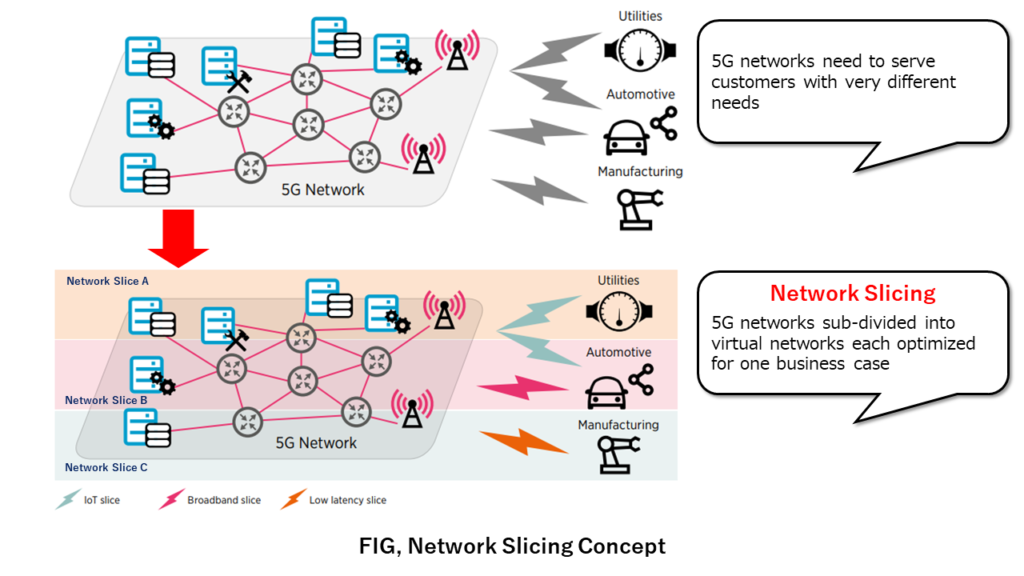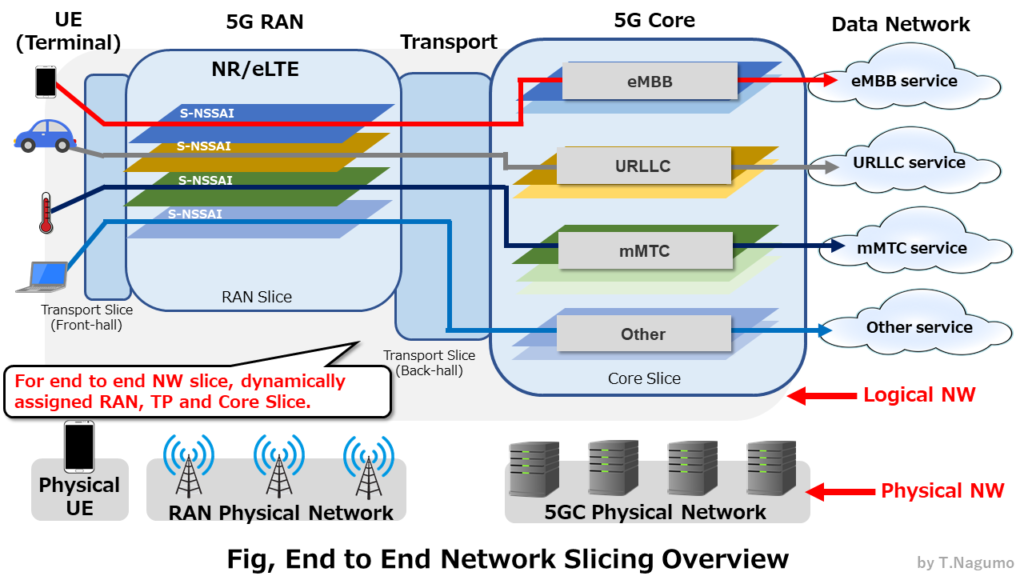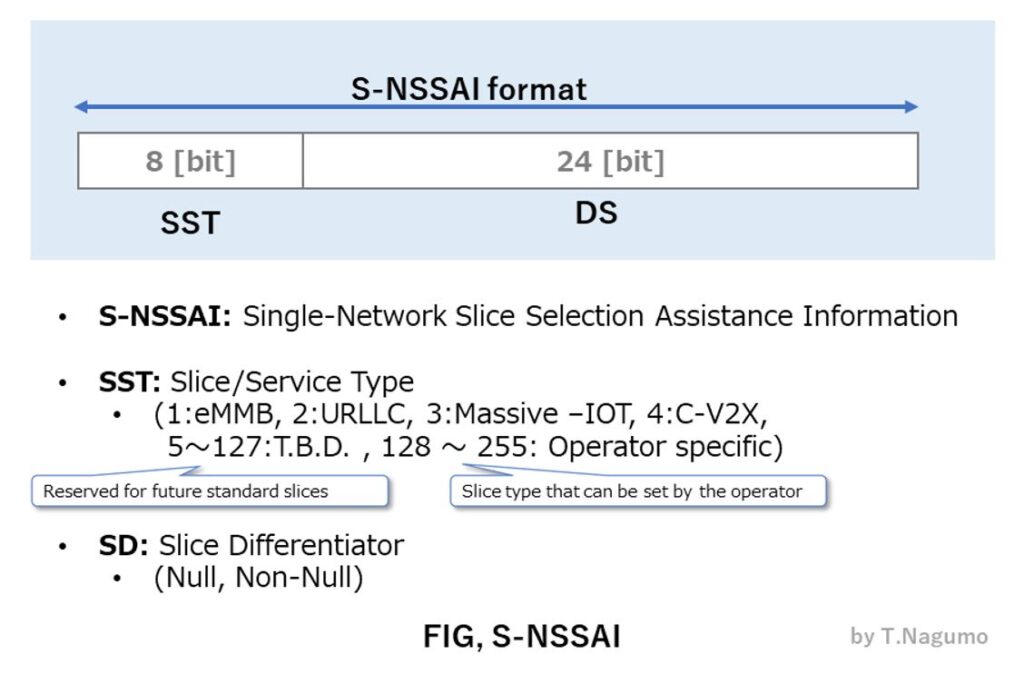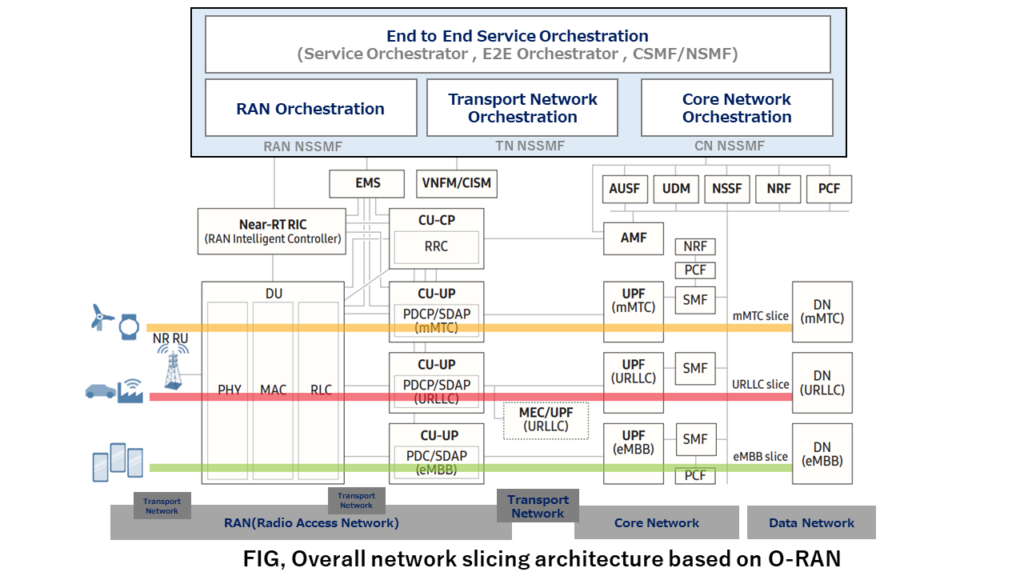Here is an overview of network slicing realized by 5G. The first edition of network slicing technical specifications was defined in the 3GPP standard Release-15. Network slicing is a virtualization technology that divides a single physical network into multiple logical networks (slices) according to different service requirements.
Network Slicing Concept
5G Network assumes that everything, not just smartphones, will be connected to 5G Network. 5G Networks need to meet a variety of different requirements such as high speed, high capacity, high reliability, and low latency. The function to meet these demands is network slicing.
Network slicing is a technology that divides a single physical network into multiple logical networks (slices) according to different service requirements.
The concept of network slicing is shown in the figure below. It is referenced from the materials of the industry group GSMA (GSM Association). A logical network (slice) that meets different requirements is configured for each slice, and each slice is used for services with different communication bands and different qualities.

test
An Introduction to Network Slicing, GSMA, [PDF file]
Outline of Network Slicing Architecture
Physical Network and Logical Network
A logical network that dynamically allocates network bandwidth and computing resources is called a network slice. The network slice can be considered separately from the physical devices that make up the network. (See the figure below)
Resources required for each RAN, Transport Network, and Core Network domain are allocated for each slice. The End-to-End network slice refers to the resources assigned to each domain of 5G Network RAN, Transport Network, and Core Network.

S-NSSAI Slice Identifier
Individual slices are formed by an identifier called S-NSSAI (Single-Network Slice Selection Assistance Information). S-NSSAI is an identifier required to achieve end-to-end network slicing. S-NSSAI can be carried around in terminals (UE), RAN, and Core Network, and is an identifier for identifying a specific network slice. S-NSSAI was defined by 3GPP, an international standards body.
eMBB (high speed/large capacity), mIoT (multi-connection, power saving, low cost), and URLLC (ultra-low latency, high reliability) are defined as service types (SST: Slice and Service Type). Single UE can have multiple S-NSSAIs. The UE is mapped to the corresponding transport slice based on the SST and SD values for each service it connects to.

End to End Network Slicing Architecture
Overall Network Slicing Architecture
Below is an overview of the End-to-End Network Slicing Architecture. It is referenced from the published Samsung Technical White Paper.
RAN and CN provide slicing-related functionality based on the architecture defined in 3GPP standard. TN provides the slicing related and coordination functions with non-3GPP part. Slicing-related functions of TN (Transport Network) and DU (Distribute Unit) networks are defined by 3GPP and provided by Network elements other than 3GPP.
Network Slicing, April 2020, Samsung, Technical White Paper, [Web Site]

Glossary in above figure
- NSSMF: Network Slice Subnet Management Function
- EMS: element management systems
- VNFM: Virtual Network Function Management
- CISM: Container Infrastructure Service Management (K8s)
- Near-RT RIC: Near Real Time RAN intelligent controller
- DU: Distributed Unit
- CU-UP: Central Unit User-Plane
- CU-CP: Central Unit Control-Plane
- UPF: User Plane Function
- DN: Data Network
- NR RU: New Radio Remote Unit
End-to-end service orchestration monitors and manages network slice capacity, authentication, Service Level Agreements (SLA), and health monitoring. The End-to-End slice is controlled to fill the SLA through each bearer pass DU, CU-UP, UPF, and DN.
Each domain resource orchestration is explained below. Each domain resource orchestration is divided into RAN, TN, and Core domains. Each domain resource orchestration is implemented in existing technologies or products (ETSI NFV-MANO, Near-Real-Time RIC, Non-Real-time RIC, NSSMF, etc.).
RAN Network Slicing
For RAN, the RIC (RAN Intelligent Controller) defined by the O-RAN Alliance is provided as a component for policy enforcement and real-time control. RIC is an AI/ML (Artificial Intelligence/Machine Learning) based intelligent function. Near-RT RIC (Near Real-time RIC) optimizes slices based on real-time monitoring and control of RAN data.
DU (Distributed Unit), CU-CP (Central Unit Control-Plane), and AMF (Access and Mobility Management Function) are usually shared by several network slices. On the other hand, CU-UP (Central Unit User-Plane), SMF (Session Management Function), and UPT (User-Plane Function) usually operate exclusively for a specific network slice.
Transport Network Slicing
In the case of Transport Network (TN), the slicing function is provided for each different transport network part of Front-hall, Mid-hall and Back-hall. TN orchestration manages or controls the resources for slicing the transport domain and calculates and optimizes the multi-layer path. It also coordinates Network behavior between both IP and optical domains.
Core Network Slicing
In the case of 5G Core, Core Network functions are provided as slices to provide specific services to various users. Some core network functionality is shared across multiple slices. Also, another core network feature is only available for certain slices of service.
UDM (Unified Data Management) and NSSF (Network Slice Selection Function) are shared by all network slices. On the other hand, NRF (Network Repository Function) and PCF (Policy Control Function) can be operated as common or network slice specific.
Summary
We have summarized the outline of network slicing realized by 5G. Network Slicing is a function that flexibly responds to various demands in 5G.
In order to realize network slicing, it is important to make 5G Network software (virtualization) and cloud-native. Please refer to the following blog-post for details on 5G virtualization and cloud native.




コメント